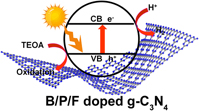Crossref Citations
This article has been cited by the following publications. This list is generated based on data provided by
Crossref.
Wang, Shuaijun
He, Fengting
Dong, Pei
Tai, Zhaoxin
Zhao, Chaocheng
Wang, Yongqiang
Liu, Fang
and
Li, Lin
2018.
Simultaneous morphology, band structure, and defect optimization of graphitic carbon nitride microsphere by the precursor concentration to boost photocatalytic activity.
Journal of Materials Research,
Vol. 33,
Issue. 23,
p.
3917.
Liu, Shuilian
Chen, Jianlin
Xu, Difa
Zhang, Xiangchao
and
Shen, Mengyao
2018.
Enhanced photocatalytic activity of directZ-scheme Bi2O3/g-C3N4composites via facile one-step fabrication.
Journal of Materials Research,
Vol. 33,
Issue. 10,
p.
1391.
Weng, Guo‐Ming
Xie, Yu
Wang, Hang
Karpovich, Christopher
Lipton, Jason
Zhu, Junqing
Kong, Jaemin
Pfefferle, Lisa D.
and
Taylor, André D.
2019.
A Promising Carbon/g‐C3N4 Composite Negative Electrode for a Long‐Life Sodium‐Ion Battery.
Angewandte Chemie International Edition,
Vol. 58,
Issue. 39,
p.
13727.
Pu, Yu
Luo, Yidan
Wei, Xiaoqian
Sun, Jingfang
Li, Lulu
Zou, Weixin
and
Dong, Lin
2019.
Synergistic effects of Cu2O-decorated CeO2 on photocatalytic CO2 reduction: Surface Lewis acid/base and oxygen defect.
Applied Catalysis B: Environmental,
Vol. 254,
Issue. ,
p.
580.
Liu, Peng
Yi, Jianhong
Bao, Rui
and
Fang, Dong
2019.
A flower-like Zn3V2O8/Ag composite with enhanced visible light driven photocatalytic activity: the triple-functional roles of Ag nanoparticles.
New Journal of Chemistry,
Vol. 43,
Issue. 19,
p.
7482.
Li, Huijie
Zhao, Jingli
Geng, Yan
Li, Zhongjun
Li, Yike
and
Wang, Jianshe
2019.
Construction of CoP/B doped g-C3N4 nanodots/g-C3N4 nanosheets ternary catalysts for enhanced photocatalytic hydrogen production performance.
Applied Surface Science,
Vol. 496,
Issue. ,
p.
143738.
Weng, Guo‐Ming
Xie, Yu
Wang, Hang
Karpovich, Christopher
Lipton, Jason
Zhu, Junqing
Kong, Jaemin
Pfefferle, Lisa D.
and
Taylor, André D.
2019.
A Promising Carbon/g‐C3N4 Composite Negative Electrode for a Long‐Life Sodium‐Ion Battery.
Angewandte Chemie,
Vol. 131,
Issue. 39,
p.
13865.
Chu, Jiayu
Sun, Guoji
Han, Xijiang
Chen, Xin
Wang, Jiajun
Hu, Wen
Waluyo, Iradwikanari
Hunt, Adrian
Du, Yunchen
Song, Bo
and
Xu, Ping
2019.
Ultrafine CoO nanoparticles as an efficient cocatalyst for enhanced photocatalytic hydrogen evolution.
Nanoscale,
Vol. 11,
Issue. 33,
p.
15633.
Zhu, Bangtong
Xu, Guangqing
Li, Xia
Wang, Zhiwei
Lv, Jun
Shu, Xia
Huang, Jun
Zheng, Zhixiang
and
Wu, Yucheng
2019.
Ultrathin porous g-CN nanosheets fabricated by direct calcination of pre-treated melamine for enhanced photocatalytic performance.
Journal of Materials Research,
Vol. 34,
Issue. 20,
p.
3462.
Acharya, Lopamudra
Nayak, Susanginee
Pattnaik, Sambhu Prasad
Acharya, Rashmi
and
Parida, Kulamani
2020.
Resurrection of boron nitride in p-n type-II boron nitride/B-doped-g-C3N4 nanocomposite during solid-state Z-scheme charge transfer path for the degradation of tetracycline hydrochloride.
Journal of Colloid and Interface Science,
Vol. 566,
Issue. ,
p.
211.
Shen, Qianhong
Wu, Chengyan
You, Zengyu
Huang, Feilong
Sheng, Jiansong
Zhang, Fang
Cheng, Di
and
Yang, Hui
2020.
g-C3N4 nanoparticle@porous g-C3N4 composite photocatalytic materials with significantly enhanced photo-generated carrier separation efficiency.
Journal of Materials Research,
Vol. 35,
Issue. 16,
p.
2148.
Wang, Zhenyu
Lee, Hyeonseok
Chen, Jianan
Wu, Muyan
Leung, Dennis Y.C.
Grimes, Craig A.
Lu, Zhouguang
Xu, Zhenghe
and
Feng, Shien-Ping
2020.
Synergistic effects of Pd–Ag bimetals and g-C3N4 photocatalysts for selective and efficient conversion of gaseous CO2.
Journal of Power Sources,
Vol. 466,
Issue. ,
p.
228306.
Chuaicham, Chitiphon
Karthikeyan, Sekar
Pawar, Radheshyam R.
Xiong, Yihuang
Dabo, Ismaila
Ohtani, Bunsho
Kim, Yoonyoung
Song, Jun Tae
Ishihara, Tatsumi
and
Sasaki, Keiko
2020.
Energy-resolved distribution of electron traps for O/S-doped carbon nitrides by reversed double-beam photoacoustic spectroscopy and the photocatalytic reduction of Cr(vi).
Chemical Communications,
Vol. 56,
Issue. 26,
p.
3793.
Barrio, Jesús
Volokh, Michael
and
Shalom, Menny
2020.
Polymeric carbon nitrides and related metal-free materials for energy and environmental applications.
Journal of Materials Chemistry A,
Vol. 8,
Issue. 22,
p.
11075.
Wei, Bo
Mei, Qiong
An, Zexiu
Li, Mingxue
Qiu, Zhaoxu
Bo, Xiaofei
and
He, Maoxia
2021.
Nonmetal-Doped C2N Nanosheets for Removal of Methoxyphenols: A First-Principles Study.
ACS Applied Nano Materials,
Vol. 4,
Issue. 1,
p.
478.
Wu, Chenyan
Huang, Feilong
Shen, Qianhong
Yu, LiXin
Zhang, Changteng
Sheng, Jiansong
Cheng, Di
and
Yang, Hui
2021.
Construction of magnetically separable hierarchical Z-scheme NiFe2O4@Bi2Sn2O7 heterojunction with enhanced visible-light photocatalytic activity.
Journal of Materials Research,
Vol. 36,
Issue. 16,
p.
3366.
Pu, Yu
Li, Wanqin
Cai, Yandi
Wei, Xiaoqian
Wang, Xin
Chen, Chong
Zou, Weixin
and
Dong, Lin
2021.
Effects of different treatment atmospheres on CeO2/g-C3N4 photocatalytic CO2 reduction: good or bad?.
Catalysis Science & Technology,
Vol. 11,
Issue. 8,
p.
2827.
Arunraj, Balasubramanian
Kaushik, Undru Sri Guna
Rajesh, Vidya
and
Rajesh, N.
2021.
Combinative influence of graphitic carbon nitride and Halomonas BVR1 bacteria augment the adsorptive recovery of precious ‘Euro’pium.
Chemical Engineering Journal,
Vol. 404,
Issue. ,
p.
126466.
Yang, Kai
Li, Rui
Zhu, Chundong
and
Pei, Jianzhong
2021.
Preparation, characterization and photocatalytic degradation efficacy of bismuth oxide under visible and ultraviolet light.
Journal of Materials Research,
Vol. 36,
Issue. 14,
p.
2936.
Lee, Kyu Ha
Chu, Ji Young
Kim, Ae Rhan
and
Yoo, Dong Jin
2022.
Simultaneous improvement of anion conductivity and cell durability through the formation of dense ion clusters of F-doped graphitic carbon nitride/quaternized poly(phenylene oxide) composite membrane.
Journal of Membrane Science,
Vol. 650,
Issue. ,
p.
120384.
